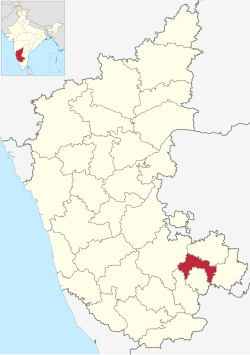Bangalore Rural district
This article needs additional citations for verification. (January 2007) |
Bengaluru Rural district | |
|---|---|
 A view of Devanahalli near Kempegowda International Airport | |
 Location in Karnataka, India | |
| Coordinates: 13°16′50″N 77°37′21″E / 13.280602°N 77.622607°E | |
| Country | India |
| State | Karnataka |
| Talukas | Devanahalli, Doddaballapura, Hoskote, Nelamangala |
| Government | |
| • Deputy Commissioner | P. N Ravindra, IAS |
| Area | |
| • Total | 2,298 km2 (887 sq mi) |
| Population (2011)[1] | |
| • Total | 990,923 |
| • Density | 430/km2 (1,100/sq mi) |
| Languages | |
| • Official | Kannada |
| Time zone | UTC+5:30 (IST) |
| Telephone code | + 91-80 |
| Vehicle registration |
|
| Website | bangalorerural |
Bengaluru Rural District is one of the 30 districts in Karnataka, India. It was formed in 1986, when Bengaluru was divided into Bengaluru (rural) and Bengaluru (urban). Presently in Bengaluru Rural district, there are 1 division, 4 Talukas, 20 Hoblis (cluster of villages), 1,065 inhabited, 5 towns, and 66 Gram Panchayats. Proximity to the city of Bengaluru has its own impact on the district, with a considerable daily commuting population. The rural people are mostly agriculturists, although with the advent of SEZs in the area, service and IT industries are booming. Devanahalli is set to be the site of a 95 billion Devanahalli Business Park, near the Bengaluru International Airport.[2]
According to the 2001 census, the total population of the district was, 1,881,514 of which 21.65% were urban[3] with a population density of 309 persons per km2. Bangalore Rural district has 22.5% of its population belonging to the Scheduled Caste and Scheduled Tribe. Hinduism is the major religion of this district. The Bengaluru Rural district is essentially an agriculture district but it has sufficient scope for Industrialisation, Dairy development and Sericulture.
It is the second least populous district in Karnataka (out of 30), after Kodagu.[4] The district is endowed with agricultural and horticultural crops such as ragi, rice, groundnut, sugarcane, castor, grapes, mulberry, etc. There are adequate infrastructural facilities such as transport and communications, banking, credit, and marketing. Though the region is not rich in mineral resources, its non-metallic mineral resources are utilised for bricks, tiles, and stoneware manufacture. For many years, weaving has also been a major occupation for a large section of the population. The soil and such climatic conditions are congenial for the cultivation of mulberry, rearing of silkworms, and production of silk, besides other agro-based industries. There are a number of wineries and quantity of production of wine has been increasing. There is a proposal by the Government of Karnataka to rename Bengaluru Rural district to Kempe Gowda. In September 2007, the taluks of Kanakapura, Ramanagara, Magadi and Channapatna were merged to form the Ramanagara district.
Demographics
According to the 2011 census Bengaluru Rural district has a population of 990,923,[4] roughly equal to the nation of Fiji[5] or the US state of Montana.[6] This gives it a ranking of 449th in India (out of a total of 640).[4] The district has a population density of 441 inhabitants per square kilometre (1,140/sq mi) .[4] Its population growth rate over the decade 2001-2011 was 16.02%.[4] Bengaluru Rural has a sex ratio of 945 females for every 1000 males,[4] and a literacy rate of 78.29%.[4]
| Year | Pop. | ±% p.a. |
|---|---|---|
| 1901 | 226,341 | — |
| 1911 | 238,293 | +0.52% |
| 1921 | 238,783 | +0.02% |
| 1931 | 262,885 | +0.97% |
| 1941 | 295,399 | +1.17% |
| 1951 | 358,106 | +1.94% |
| 1961 | 406,828 | +1.28% |
| 1971 | 484,947 | +1.77% |
| 1981 | 608,535 | +2.30% |
| 1991 | 717,525 | +1.66% |
| 2001 | 850,968 | +1.72% |
| 2011 | 990,923 | +1.53% |
| source:[7] | ||
References
- ^ a b Bangalore Rural (Bengaluru Rural) District Population Census 2011, Karnataka literacy sex ratio and density
- ^ "Karnataka focuses on infrastructure development | Business Line". Thehindubusinessline.com. 5 September 2009. Retrieved 2 March 2016.
- ^ https://web.archive.org/web/20100111052456/http://www.censusindiamaps.net/page/India_WhizMap/IndiaMap.htm. Archived from the original on 11 January 2010. Retrieved 27 August 2009.
{{cite web}}: Missing or empty|title=(help) - ^ a b c d e f g "District Census 2011". Census2011.co.in. 2011. Retrieved 30 September 2011.
- ^ US Directorate of Intelligence. "Country Comparison:Population". Retrieved 1 October 2011.
Fiji 883,125 July 2011 est.
- ^ "2010 Resident Population Data". U. S. Census Bureau. Archived from the original on 19 October 2013. Retrieved 30 September 2011.
Montana 989,415
- ^ Decadal Variation In Population Since 1901
